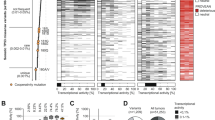Abstract
A single-nucleotide polymorphism (SNP) in exon 4 results in expression of either arginine (72R) or proline (72P) at codon 72 of p53. We demonstrate that the in vitro response of cells exposed to anticancer agents is strongly influenced by this SNP in wild-type p53. In inducible systems and in cells expressing the endogenous protein, expression of 72P wild-type p53 results in a predominant G1 arrest, with only a minor apoptosis, at drug concentrations causing extensive apoptosis in cells expressing the 72R wild-type variant. The superior apoptosis-inducing activity of the 72R form correlates with more efficient induction of specific apoptosis-associated genes, and is maximal in the presence of serine 46 (S46). In vivo, the outcome of chemo-radiotherapy of squamous carcinomas is more favourable in cancers retaining a wild-type 72R allele, such cases having higher response rates and longer survival than those with wild-type 72P. Together, these results reveal that this SNP is an important determinant of response to anticancer agents in cells expressing wild-type p53. Analysis of complete p53 genotype (mutation and SNP) merits detailed investigation as a simple means for prediction of treatment response and survival in clinical oncology.
This is a preview of subscription content, access via your institution
Access options
Subscribe to this journal
Receive 50 print issues and online access
$259.00 per year
only $5.18 per issue
Buy this article
- Purchase on Springer Link
- Instant access to full article PDF
Prices may be subject to local taxes which are calculated during checkout






Similar content being viewed by others
References
Allday MJ, Inman GJ, Crawford DH and Farrell PJ . (1995). EMBO J., 14, 4994–5005.
Baptiste N, Friedlander P, Chen X and Prives C . (2002). Oncogene, 21, 9–21.
Bergamaschi D, Gasco M, Hiller L, Sullivan A, Syed N, Trigiante G, Yulug I, Merlano M, Numico G, Comino A, Attard M, Gusterson B, Bell AK, Heath V, Tavassoli M, Reelfs O, Farrell PJ, Smith P, Lu X and Crook T . (2003). Cancer Cell, 3, 387–402.
Dumont P, Leu JI, Della Pietra III AC, George DL and Murphy M . (2003). Nat. Genet., 33, 357–365.
el-Deiry WS . (1998). Semin. Cancer Biol., 8, 345–357.
Johnstone RW, Ruefli AA and Lowe SW . (2002). Cell, 108, 153–164.
Kaeser MD and Iggo RD . (2002). Proc. Natl. Acad. Sci. USA, 99, 95–100.
Kaplan EL and Meier P . (1958). J. Am. Statisticians Assoc., 53, 457.
Lowe SW, Bodis S, McClatchey A, Remington L, Ruley HE, Fisher ED, Housman DE and Jacks T . (1994). Science, 266, 807–810.
Lowe SW, Ruley HE, Jacks T and Housman DE . (1993). Cell, 75, 957–967.
Marin MC, Jost CA, Brooks LA, Irwin MS, O'Nions J, Tidy JA, James N, McGregor JM, Harwood CA, Yulug IG, Vousden KH, Allday MJ, Gusterson B, Ikawa S, Hinds PW, Crook T and Kaelin Jr WG . (2000). Nat. Genet., 25, 47–54.
Matlashewski GJ, Tuck S, Pim D, Lamb P, Schneider J and Crawford LV . (1987). Mol. Cell. Biol., 7, 961–963.
Nakano K and Vousden KH . (2001). Mol. Cell, 7, 683–694.
Oda K, Arakawa H, Tanaka T, Matsuda K, Tanikawa C, Mori T, Nishimori H, Tamai K, Tokino T, Nakamura Y and Taya Y . (2000). Cell, 102, 849–862.
Oda E, Ohki R, Murasawa H, Nemoto J, Shibue T, Yamashita T, Tokino T, Taniguchi T and Tanaka N . (2000). Science, 288, 1053–1058.
Peto R, Pike MC, Armitage P, Breslow NE, Cox DR, Howard SV, Mantel N, McPherson K, Peto J and Smith PG . (1977). Br. J. Cancer, 35, 1–39.
Pim D and Banks L . (2004). Int. J. Cancer, 108, 196–199.
Schmitt CA, Fridman JS, Yang M, Baranov E, Hoffman RM and Lowe SW . (2002). Cancer Cell, 1, 289–298.
Shibue T, Takeda K, Oda E, Tanaka H, Murasawa H, Takaoka A, Morishita Y, Akira S, Taniguchi T and Tanaka N . (2003). Genes Dev., 17, 2233–2238.
Sjalander A, Birgander R, Kivela A and Beckman G . (1995). Hum. Hered., 45, 144–149.
Thomas M, Kalita A, Labrecque S, Pim D, Banks L and Matlashewski G . (1999). Mol. Cell. Biol., 19, 1000–1092.
Villunger A, Michalak EM, Coultas L, Mullauer F, Bock G, Ausserlechner MJ, Adams JM and Strasser A . (2003). Science, 302, 1036–1038.
Vogelstein B, Lane D and Levine AJ . (2000). Nature, 307–310.
Vousden KH and Lu X . (2002). Nat. Rev. Cancer, 2, 594–604.
Yu J, Wang Z, Kinzler KW, Vogelstein B and Zhang L . (2003). Proc. Natl. Acad. Sci. USA, 100, 1931–1936.
Yu J, Zhang L, Hwang PM, Kinzler KW and Vogelstein B . (2001). Mol. Cell, 7, 673–682.
Acknowledgements
We thank Compagnia di San Paolo for supporting parts of this work.
Author information
Authors and Affiliations
Corresponding author
Rights and permissions
About this article
Cite this article
Sullivan, A., Syed, N., Gasco, M. et al. Polymorphism in wild-type p53 modulates response to chemotherapy in vitro and in vivo. Oncogene 23, 3328–3337 (2004). https://doi.org/10.1038/sj.onc.1207428
Received:
Revised:
Accepted:
Published:
Issue Date:
DOI: https://doi.org/10.1038/sj.onc.1207428
Keywords
This article is cited by
-
Polymorphisms in MDM2 and TP53 Genes and Risk of Developing Therapy-Related Myeloid Neoplasms
Scientific Reports (2019)
-
Towards standardization of next-generation sequencing of FFPE samples for clinical oncology: intrinsic obstacles and possible solutions
Journal of Translational Medicine (2017)
-
TP53 Arg72 as a favorable prognostic factor for Chinese diffuse large B-cell lymphoma patients treated with CHOP
BMC Cancer (2017)
-
Does p53 codon 72 polymorphism have a prognostic value in carcinoma of the vulva and vagina?
Medical Oncology (2017)
-
Genetic risk of subsequent esophageal cancer in lymphoma and breast cancer long-term survival patients: a pilot study
The Pharmacogenomics Journal (2016)



